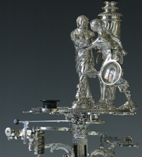Press Release
A major new exhibition at the Museum of the History of Science will bring together some of the finest architectural and scientific material from the early modern period including Sir Christopher Wren's drawings of St Paul's Cathedral, architectural drawings by King George III and an astrolabe made for Queen Elizabeth I.
Compass and Rule focuses on design and drawing, exploring the role of geometry in the dramatic transformation of English architecture between the 16th and 18th centuries. During this time new concepts of design based on geometry changed how architects worked and what they built, as well as the intellectual status and social standing of their discipline. Identified as a branch of practical mathematics, architecture became the most artistic of the sciences and the most scientific of the arts.

George III microscope
Extraordinary drawings, unique instruments and rare books provide a new perspective on the emerging role of the architect – from Henry VIII's military engineers to Christopher Wren as astronomer and architect, from Elizabethan mathematical practitioners to the architectural apprenticeship of George III.
The exhibition has been co-curated by Dr Anthony Gerbino and Dr Stephen Johnston, who bring together two academic disciplines, the histories of architecture and of science.
Compass and Rule: Architecture as Mathematical Practice in England, 1500 – 1750 runs between 16th June and 6th September 2009 in Oxford before travelling to the Yale Center for British Art in New Haven.
Download the programme of events related to Compass and Rule.

